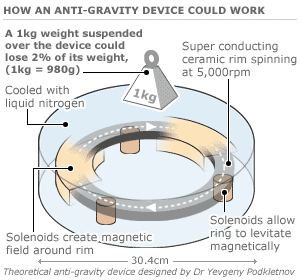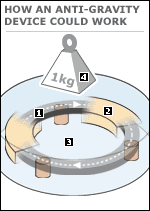|
Project GRASP |
| Gravity Shielding Still Science
Fiction, Boeing Says
By Jim Banke Senior Producer, Cape Canaveral Bureau posted: 02:25 pm ET 31 July 2002 Source Article CAPE CANAVERAL, Fla. -- Artificial gravity on spaceships
and rockets levitating themselves into orbit will remain the stuff of science
fiction for some time to come, despite recent reports in Europe that researchers
with U.S. aerospace giant Boeing are working on the concept.
Jane's quoted from a Boeing document entitled "Gravity Research for Advanced Space Propulsion" (GRASP) it had obtained that said "If gravity modification is real, it will alter the entire aerospace business." The document also said, according to the report, that Boeing was actively seeking out the collaboration of Evgeny Podkletnov, a Russian scientist well known among gravity researchers who has experimented with the technology in Russia and Finland. Almost true, Boeing told SPACE.com Wednesday in a prepared statement. "We are aware of Podkletnov's work on 'anti-gravity' devices and would be interested in seeing further development work being done. However, Boeing is not funding any activities in this area at this time," the statement said. "The recent report that we are is based on a misinterpretation of information. For instance, GRASP is not a codename for a current project but rather an acronym for a presentation entitled "Gravity Research for Advanced Space Propulsion," in which a Boeing engineer explains Podkletnov's theory and proposes that we should continue to monitor this work and perhaps even conduct some low-cost experiments to further assess its plausibility. No steps have been taken beyond this point by Boeing." According to Cook's report, the GRASP document made these observations about Podkletnov's work:
|
More Stories
|
| © Imaginova Corp. All rights reserved.
http://www.space.com/businesstechnology/technology/gravity_research_020731.html |
| Anti-gravity propulsion comes
‘out of the closet’
Nick Cook, JDW Aerospace Consultant, London - Jane's Defense Weekly original source | fair use notice Summary: Boeing, the world’s largest aircraft manufacturer, has admitted it is working on experimental anti-gravity projects that could overturn a century of conventional aerospace propulsion technology if the science underpinning them can be engineered into hardware. |
|
Boeing, the world’s largest aircraft
manufacturer, has admitted it is working on experimental anti-gravity projects
that could overturn a century of conventional aerospace propulsion technology
if the science underpinning them can be engineered into hardware.
As part of the effort, which is being run out of Boeing’s
Phantom Works advanced research and development facility in Seattle, the
company is trying to solicit the services of a Russian scientist who claims
he has developed anti-gravity devices in Russia and Finland. The approach,
however, has been thwarted by Russian officialdom.
The Boeing drive to develop a collaborative relationship with the scientist in question, Dr Evgeny Podkletnov, has its own internal project name: ‘GRASP’ — Gravity Research for Advanced Space Propulsion. A GRASP briefing document obtained by JDW sets out what Boeing believes to be at stake. "If gravity modification is real," it says, "it will alter the entire aerospace business." GRASP’s objective is to explore propellentless propulsion (the aerospace world’s more formal term for anti-gravity), determine the validity of Podkletnov’s work and "examine possible uses for such a technology". Applications, the company says, could include space launch systems, artificial gravity on spacecraft, aircraft propulsion and ‘fuelless’ electricity generation — so-called ‘free energy’. But it is also apparent that Podkletnov’s work could be engineered into a radical new weapon. The GRASP paper focuses on Podkletnov’s claims that his high-power experiments, using a device called an ‘impulse gravity generator’, are capable of producing a beam of ‘gravity-like’ energy that can exert an instantaneous force of 1,000g on any object — enough, in principle, to vaporise it, especially if the object is moving at high speed. Podkletnov maintains that a laboratory installation in Russia has already demonstrated the 4in (10cm) wide beam’s ability to repel objects a kilometre away and that it exhibits negligible power loss at distances of up to 200km. Such a device, observers say, could be adapted for use as an anti-satellite weapon or a ballistic missile shield. Podkletnov declared that any object placed above his rapidly spinning superconducting apparatus lost up to 2% of its weight. Although he was vilified by traditionalists who claimed that gravity-shielding was impossible under the known laws of physics, the US National Aeronautics and Space Administration (NASA) attempted to replicate his work in the mid-1990s. Because NASA lacked Podkletnov’s unique formula for the work, the attempt failed. NASA’s Marshall Space Flight Center in Alabama will shortly conduct a second set of experiments using apparatus built to Podkletnov’s specifications. Boeing recently approached Podkletnov directly, but promptly fell foul of Russian technology transfer controls (Moscow wants to stem the exodus of Russian high technology to the West). The GRASP briefing document reveals that BAE Systems and Lockheed Martin have also contacted Podkletnov "and have some activity in this area". It is also possible, Boeing admits, that "classified
activities in gravity modification may exist". The paper points out that
Podkletnov is strongly anti-military and will only provide assistance if
the research is carried out in the ‘white world’ of open development.
|
| Boeing tries to defy gravity
BBC News Article
Researchers at the world's largest
aircraft maker, Boeing, are using the work of a controversial Russian scientist
to try to create a device that will defy gravity.
The company is examining an experiment by Yevgeny Podkletnov, who claims to have developed a device which can shield objects from the Earth's pull.

Dr Podkletnov is viewed with suspicion by many conventional scientists. They have not been able to reproduce his results. The project is being run by the top-secret Phantom Works in Seattle, the part of the company which handles Boeing's most sensitive programmes. The head of the Phantom Works, George Muellner, told the security analysis journal Jane's Defence Weekly that the science appeared to be valid and plausible. Dr Podkletnov claims to have countered the effects of gravity in an experiment at the Tampere University of Technology in Finland in 1992. The scientist says he found that objects above a superconducting ceramic disc rotating over powerful electromagnets lost weight. The reduction in gravity was small, about 2%, but the implications - for example, in terms of cutting the energy needed for a plane to fly - were immense. Scientists who investigated Dr Podkletnov's work, however, said the experiment was fundamentally flawed and that negating gravity was impossible. Research explored But documents obtained by Jane's Defence Weekly and seen by the BBC show that Boeing is taking Dr Podkletnov's research seriously. The hypothesis is being tested in a programme codenamed Project Grasp. Boeing is the latest in a series of high-profile institutions trying to replicate Dr Podkletnov's experiment. The military wing of the UK hi-tech group BAE Systems is working on an anti-gravity programme, dubbed Project Greenglow. The US space agency, Nasa, is also attempting to reproduce Dr Podkletnov's findings, but a preliminary report indicates the effect does not exist. |
|
To Avoid confusion here are some other Project GRASP search results:
|
| FAIR USE NOTICE: This page contains copyrighted material the use of which has not been specifically authorized by the copyright owner. Pegasus Research Consortium distributes this material without profit to those who have expressed a prior interest in receiving the included information for research and educational purposes. We believe this constitutes a fair use of any such copyrighted material as provided for in 17 U.S.C § 107. If you wish to use copyrighted material from this site for purposes of your own that go beyond fair use, you must obtain permission from the copyright owner. |
|
|

